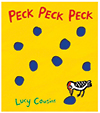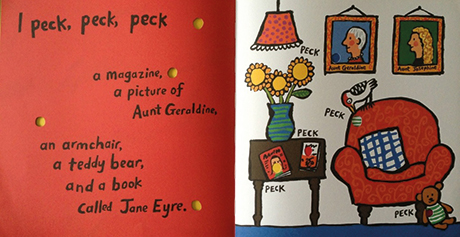
Download the PDF of this article
This colourful yet simply drawn book is the story about a young woodpecker. Urged by its father to learn to peck, it flies off to practise the skill. The reader can see the result of each peck by the increasing number of holes that appear in the illustrations. After its pecking frenzy, the little woodpecker becomes tired and flies back home, where its father applauds its efforts.
Primary colours, the quickening pace of the rhyme and ever more holes on each new page all capture the woodpecker’s growing excitement and determination to master a new skill. Children will love the humour and the unintended consequences that come from the bird simply doing what it is told!
A GOOD CHOICE
 This wonderful book will appeal to children between the ages of two and six. All will enjoy seeing what the woodpecker makes holes in, while children who are interested in letters and words will be able to read some of the text. It might be one to suggest to fathers as the story involves a father-child relationship.
This wonderful book will appeal to children between the ages of two and six. All will enjoy seeing what the woodpecker makes holes in, while children who are interested in letters and words will be able to read some of the text. It might be one to suggest to fathers as the story involves a father-child relationship.
SHARING THIS BOOK
In this book there are holes in the cover and in each subsequent page. Little fingers will want to find their way through the hole and talk about them. It is, therefore, worth considering sharing this book as a one-to-one or in pairs to start with.
This is a book where there is plenty for children to look at and so once you have read the text, it is worth pausing. Children may want to find each item that has been pecked or make a comment. On first reading, consider following children’s lead in terms of discussion and the pace of the book. On a second reading, you can start to explore the book in more depth.
You may need to see if children know what some of the items are, such as a nectarine or the names of the tools in the kitchen.
SUPPORTING LEARNING
Mathematics
There are plenty of counting opportunities in this book. You could look at each page and count the number of holes. With older children, this could be recorded with numerals. It would also be possible to talk about which pages have the most and fewest holes pecked.
Language
There are several ways in which distinct areas of language can be encouraged. First, you can see if children can match the ‘hole’ to the item listed. This can help children learn vocabulary and associate a word with and object. You could also create a picture lotto game so that the items that have been ‘pecked’ are drawn on the cards.
You could emphasise the rhymes that appear on some of the pages. Children may also be able to put in a final rhyming word.
Personal, social and emotional development
There are some interesting themes that can be explored in this book. We can focus children’s attention on the way the baby woodpecker is learning a new skill. They may be able to think about new skills they have learnt and also that these required practise. If you have any photos of children acquiring these skills, you could create a display that celebrates the learning of new skills.
But what about the owner of the house? What might it be like to find holes in some of their possessions? We could encourage children to talk about this and the favourite things that they own.
Literacy
This book is quite repetitive and with some children you may be able to draw their attention to the word ‘peck’. They can then tap every time they hear the word and you could see if any older children can find it on the page. You could also look at mark-making opportunities. The children could write to the woodpecker and you could put out a hole-punch so they too can ‘peck’.
Understanding the world
This book could be a starting point for looking at birds in and around your setting. You may encourage children to set up a bird feeder, or you could share non-fiction books about different types of birds. Think also about inviting in someone from a wildlife organisation such as the Royal Society for the Protection of Birds (www.rspb.org.uk).
A QUICK TIP
Finally, a quick tip. If you do decide to purchase this book or borrow it from a library, it is worth looking out for a hardback edition. The hardback version feels better and is likely to be more robust when the children handle it.
ABOUT THIS SERIES
Over the course of this monthly series on sharing books with children, Penny Tassoni will look at a range of fiction and non-fiction titles, from rhyming books for babies to picture books that adults and children can explore together.









